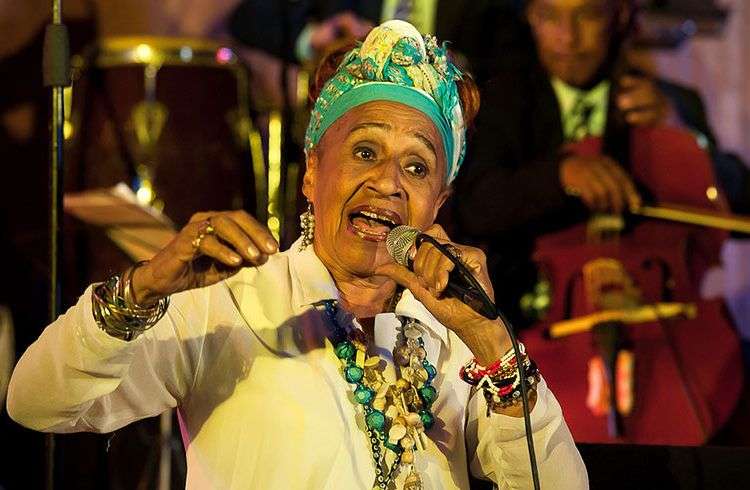Regla Teresa García Caturla, better known as Tete Caturla, is considered young despite her age, her voice has not lost its tone all along decades, and her smile remains affable and revealing secrets. She is not only remembered as part of Las D’Aida legendary quartet, but at almost 80 she continues to give her best to further magnify Cuban art.
From the comfort of her home in a very central area of Havana’s Vedado neighborhood, Tete told OnCuba about her first steps in Cuban music. While speaking of her beginnings, she sometimes posed a nostalgic look at past glories, but immediately regained the joy of a renewed present.
“It can be said it’s been a lifetime on stage: five decades is too long; but I’m struggling, I’m not tired, and we must continue till the body gives out, ” Tete Caturla said.
“I never thought to enter Las D’Aida quartet. To me that seemed unattainable. However, my nephew Fabian, instrumentalist at the Cuban Radio Institute, told me one day in 1963 that the group had returned from Europe and they lacked a voice. He asked me if I was interested, but I had doubts; I thought I did not reach such a high level. Finally one of my sisters, Sofia, encouraged me and I went to an audition. They tried me and… I passed”, she noted.
And there began the challenge of singing with Las D’Aida…
¡A challenge! Because that was such a quartet, with wonderful voices that have given so much to the culture of our country. At that time there were other bands with very good quality, but Las D’Aida distinguished among them. This group was the first using bata drums. Its director died in 1973 and I moved on to lead the quartet, to which I added an accompanying group. So I remained until 1998.
What do the names of Haydée and Omara Portuondo, Moraima Secada, Elena Burke mean to you?
To me they were the guides; but my great teacher was Aida Diestro. She determined my career, and made me a true professional.
At the end of 1998 you retired from the quartet and the group, but did not completely disassociate from art. How do you remain connected to the world of voices and instruments?
I was linked for a while to the Afro-Cuban All Star project: Cuban musician Juan de Marcos González called me and we did some work together. Then I pulled away and started to do different activities on my own, in isolation, until I created Son Caturla group, with which I work now, every night, at the Pico Blanco restaurant in Saint John’s Hotel. My son is the manager and percussionist.
Every night? At your age ?
(Laughs) That energy comes from Las D’Aida, that was the style of the quartet. Professionalism steals you the sleep and fatigue. Now I am 77 years old and the secret to stay active is practicing sports, if possible. When I lived in Remedios I used to play basketball and volleyball. Believe it or not I still do the chekeré step. All foreigners ask my age, and they get amazed when I tell them I am 77.
What kind of show do you do at Saint John’s?
We do the show Traditional of the fifties, directed by my brother Francisco. It features figures like Ela Calvo, Muso, Orestes Macias, Raquel Hernandez, Pablo Santamaria, Mule, Mundito Gonzalez, among others.
In addition to your personal achievements, you are the daughter of one of the greats of Cuban music. How does it feel to take the blood of Alejandro García Caturla?
It is a big challenge. His work has been an inspiration and it causes immense respect. I’m still reading the books that have been written about him. My father had a feeling that he would not reach the age of forty, and so it was, unfortunately. He was very dynamic and active.
Analyzing the future of some popular Cuban bands, we can perceive that quartets no longer abound…
It is a pity. Tradition has been lost; though sometimes it emerges a talented quartet, which bets for Cuban music. But I must confess something: singing in quartet is not easy. They have to achieve complementation and empathy among all members, and achieving that is difficult at times.
How do you want Cuban people to remember Las D’Aida quartet?
I wish them to fondly remember us forever. Aida made a wonderful work with us. I still own that style and sometimes Omara and I are invited to sing together on television and relive that period of glory.
Are you satisfied with what you have accomplished to bring to the Cuban culture in music?
I think I can give a lot more, because identity is the biggest thing a Cuban owns. Once, a foreigner asked me why our music liked so much, and I told him it could be by its taste. He replied no, that it was mainly due to the Cuban identity. He convinced me that it was true.
And I’m sure that Cuban music has the same label despite not made on the island. You know when a Cuban rhythm is being played although it has been made in America or wherever. Time also makes the music to evolve, and over the years it might not be harmonically the same, and ours is very suitable for making changes, it is very rich. Foreigners love it. It is a phenomenon! The music of my country is one of the things I’m most proud. That is why I’m Cuban and I will die being Cuban.









